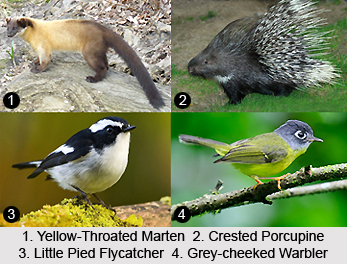Kedarnath Wildlife Sanctuary, situated in the districts of Chamoli and Rudraprayag in Uttarakhand, is spread over an area of 975 sq km. Kedarnath Wildlife Sanctuary is nestled amidst the Himalayas which is pregnant with snow capped mountainous peaks, lush green forests, lakes and glaciers, scenic valleys and contains a variety of birds and animals, along with diverse flora. It was established in 1972, mainly with the aim of protecting the rare and endangered Himalayan Musk Deer. Prior to this, the area was a Notified Reserve Forest, from 1916 and 1920. The name of the sanctuary is derived from the popular Hindu pilgrim destination of Kedarnath Temple, located on the northern region. The route from Gauri Kund to Kedarnath temple goes through the Kedarnath Wildlife sanctuary. It is also the biggest protected locale in the western Himalayas.
Topography of Kedarnath Wildlife Sanctuary
The entire sanctuary covers an area of 376 sq mi (975 sq km) with an elevation of 1,160 m to 7,068 m (near Chaukhamba peak). The geographical co-ordinates are 30degree26`00"N 78degree54`00"E30degree26` and 30degree45`00"N 79degree36`00"E. Kedarnath Wildlife Sanctuary is located in the larger Western Himalayan alpine shrub and meadows of alpine eco-region of India and the northern catchment of the Alaknanda River. The river valleys of Biera, Menan, Kali, Mandakini and Balasuti are in the north-south direction; where as the high altitude areas are embellished with glaciers.
The temperature during the summer months is mild and pleasant, around 25 degree Celsius. Where as during the winter season, the temperature drops to -10 degree Celsius followed by heavy snowfalls. The South West summer monsoon rain provides an annual rainfall of 3,093 mm.
Flora and Fauna of Kedarnath Wildlife Sanctuary
 Kedarnath Wildlife Sanctuary is rich with a wide range of vegetation and flora, like oak, rhododendrons, Chir Pine and Alpine meadows along with several Himalayan flowering plants. Grazing land, medicinal plants and other varieties of plants are also found through out the region. The sanctuary also contains numerous species of animals, birds and marine life. Some of the mammals are Himalayan Black Bear, Yellow-Throated Marten, Leopard, Snow Leopard, Leopard Cat, Fox and Jackal. Other animals include, Himalayan Musk Deer, Indian Muntjac, Wild Boar, Himalayan Tahr, Bharal, Sambar, Goral, Serow, Langur, Rhesus Macaque, Crested Porcupine, Mountain Voles, Red Giant Flying Squirrel, Brown-toothed Shrew, Pika, Snow Cock and several species of reptiles like Himalayan Pit Viper and Keelback. The exotic birds found here are, Nepal Tree-creeper, Little Pied Flycatcher, Koklass Pheasant, Grey-cheeked Warbler, Himalayan Monal and Kalij Pheasant.
Kedarnath Wildlife Sanctuary is rich with a wide range of vegetation and flora, like oak, rhododendrons, Chir Pine and Alpine meadows along with several Himalayan flowering plants. Grazing land, medicinal plants and other varieties of plants are also found through out the region. The sanctuary also contains numerous species of animals, birds and marine life. Some of the mammals are Himalayan Black Bear, Yellow-Throated Marten, Leopard, Snow Leopard, Leopard Cat, Fox and Jackal. Other animals include, Himalayan Musk Deer, Indian Muntjac, Wild Boar, Himalayan Tahr, Bharal, Sambar, Goral, Serow, Langur, Rhesus Macaque, Crested Porcupine, Mountain Voles, Red Giant Flying Squirrel, Brown-toothed Shrew, Pika, Snow Cock and several species of reptiles like Himalayan Pit Viper and Keelback. The exotic birds found here are, Nepal Tree-creeper, Little Pied Flycatcher, Koklass Pheasant, Grey-cheeked Warbler, Himalayan Monal and Kalij Pheasant.
The declining population of the Himalayan Musk Deer, due to extensive poaching, propelled the government to declare it as an endangered species in 1973. The male deer contains the precious musk pod glands which are highly valued for its use in cosmetics. Due to its high economic value and increased demand, the poaching of Himalayan Musk Deer has increased manifold.
Conservation of Kedarnath Wildlife Sanctuary
The Indian Government and World Wide Fund (WWF) have jointly operated the Threatened Deer Programme for the conservation of the Himalayan musk deer, in Kedarnath Wild Life Sanctuary. Moreover, the Forest Department of Uttarakhand set up a breeding centre at Kharchula Kharak in 1982, to promulgate Himalayan musk deer. The sanctuary was established mainly to protect the musk deer from exploitation.
Religious Significance of Kedarnath Wildlife Sanctuary
There are numerous Hindu temples located in the vicinity of the sanctuary. The Kedarnath temple is historically renowned and the most ancient temples in the region, dating back to 8th century. Moreover, other temples like Madhyamaheshwar, Mandani, Ansuya Devi, Rudranath and Tungnath are related to the Hindu epic Mahabharata.
Several tourists flock to the area to visit the temples that are scattered through out the region. Jolly Grant Airport at Dehradun is the nearest airport and Rishikesh is the nearest railway station.











